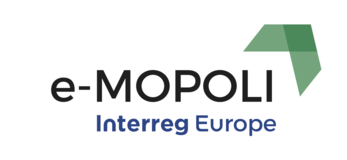The second Round table was about governance approaches of the diffusion of electric and other alternative fuel mobility in the regions. The round table was set up as a panel discussion with three speakers and a moderator. Audience participation was achieved through the use of an interactive voting tool.
The three guests from the panel were Blanka Odlazek (project leader at Business Support Centre Ltd, Kranj, from the Regional Development Agency of Gorenjska), Guido Piccoli, (director of ALOT, the Agency of Eastern Lombardia for Transport and Logistics representing Province of Brescia, lead partner of e-MOPOLI) and Jeroen Cockx, project coordinator Clean Power for Transport from the department of Environment, Nature and Energy, Flemish government. Lieselot Vanhaverbeke (professor at the Free University of Brussel and part of the research group MOBI , leader in defining the state-of-the-art in Electromobility and Socio-Economic Evaluations for sustainable mobility and logistics) was moderating the panel.

The first question asked to the panel was “How do you monitor the policy targets?” Jeroen Cockx explained that for Flanders there is a federal institution where all vehicles are registered. Here, the data comes in monthly. Then some extra information comes in through an external paid partner. Blanka stated that in Slovenia all the data is managed and provided by the statistical office. Real time data and availability is there a problem though. A national platform to combine all information on the charging infrastructure is being set up. Following Guido, Italy is in the same position. Vehicle information is available, but the use of the charging points or vehicles is more difficult.

Secondly, the moderator asked how regions can take action to reach these policy targets. Jeroen explains that in Flanders they organize a call for projects on a yearly basis. In Slovenia there are lots of different strategic subsidies to promote e-mobility, additionally they’re working with municipalities and other partners to stimulate projects. In Italy it’s a combination of both levels as well. Most regions agree that it’s a combination of both ways. Important is that both levels do not contradict each other.
To the question which sectors are involved in the strategy to reach the targets Flanders replied they call together the so called ‘CPT team’ that contains the most important stakeholders. They come together twice a year. Difficulty is the different interests within this group. In Slovenia it’s difficult to convince external stakeholders because of the obvious financial barriers. Convincing stakeholders is done project based. Italy clarifies that interaction with stakeholders happens on national and local level and that both levels have different approaches.
Three policy recommendations where derived from this:
1. Setting up a national platform to combine all information and data regarding CPT seems one of the most efficient ways.
2. Project calls work fine, at least in Flanders. Subsidies can also form an interesting trigger.
3. It is important to invite all the most important stakeholders regarding CPT and bring them together on regular basis for discussion and agreements.


![[NEWS] Brescia: E-bike sharing in Brescia](/fileadmin/user_upload/tx_tevnewsevents/news/image_1664960602.jpg)
![[NEWS] Rogaland: battery-only high speed craft](/fileadmin/user_upload/tx_tevnewsevents/news/image_1664804367.png)
![[NEWS] BSC: promoting e-mobility in Gorenjska](/fileadmin/user_upload/tx_tevnewsevents/news/image_1660136312.png)
![[NEWS] BSC: new opportunities for cooperation](/fileadmin/user_upload/tx_tevnewsevents/news/image_1660136159.jpg)
![[NEWS] Rogaland: Solar power for electric airplanes](/fileadmin/user_upload/tx_tevnewsevents/news/image_1660135530.jpg)
![[NEWS] Bucharest: decarbonization of transports](/fileadmin/user_upload/tx_tevnewsevents/news/image_1656521459.jpg)
![[NEWS] Calabria: CENTRE FOR SUSTAINABLE MOBILITY](/fileadmin/user_upload/tx_tevnewsevents/news/image_1655983407.png)
![[NEWS] BSC: rental system network for bikes](/fileadmin/user_upload/tx_tevnewsevents/news/image_1655967495.png)
![[NEWS] Attica: Electromobility in Paiania](/fileadmin/user_upload/tx_tevnewsevents/news/image_1655110894.png)
![[NEWS] Attica: First e-bike festival in Athens](/fileadmin/user_upload/tx_tevnewsevents/news/image_1655110292.png)